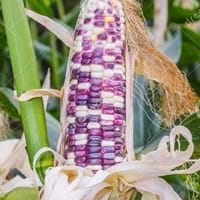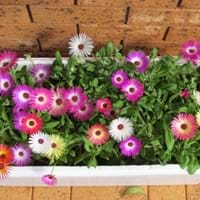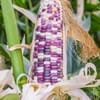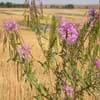Life Span
Perennial
Annual
Type
Vegetable
Flowering Plants
Origin
Hybrid origin, North America, Southeastern United States, Central America, South America
South Africa
Types
Field Corn, Sweet Corn, Baby Corn, Indian Corn
it is a type of daisy
Habitat
Clay soil areas, Loamy soils, Sandy areas
Humid climates, Warmer regions
USDA Hardiness Zone
Not Available
Not Available
Sunset Zone
A1, A2, A3, H1, H2, 1a, 1b, 2a, 2b, 3a, 3b, 4, 5, 6, 7, 8, 9, 10, 11, 12, 13, 14, 15, 16, 17, 18, 19, 20, 21, 22, 23, 24
A2, 1a, 1b, 2a, 2b, 3a, 3b, 4, 5, 6, 7, 8, 9, 10, 11, 12, 13, 14, 15, 16, 17, 18, 19, 20, 21, 22, 23, 24
Habit
Upright/Erect
Prostrate/Trailing
Flower Color
Not Available
Red
Flower Color Modifier
Bicolor
Bicolor
Fruit Color
White, Yellow, Light Yellow, Peach, Burgundy, Dark Red, Dark Blue
Brown
Leaf Color in Spring
Green, Dark Green
White, Lime Green, Ivory
Leaf Color in Summer
Green, Dark Green
White, Lime Green, Ivory
Leaf Color in Fall
Green, Dark Green
White, Lime Green, Ivory
Leaf Color in Winter
Green, Dark Green
Light Green
Leaf Shape
Long Linear
Long Linear
Plant Season
Spring, Summer, Fall
Spring, Summer, Fall, Winter
Sunlight
Full Sun
Full Sun, Partial Sun, Partial shade
Growth Rate
Very Fast
Fast
Type of Soil
Loam
Loam, Sand
The pH of Soil
Neutral
Acidic, Neutral, Alkaline
Soil Drainage
Well drained
Well drained
Bloom Time
Indeterminate
Spring, Late Spring, Early Summer, Early Fall, Fall, Late Fall, Early Winter
Tolerances
Drought
Drought
Where to Plant?
Ground
Container, Ground, Pot
How to Plant?
Seedlings
Seedlings
Plant Maintenance
Medium
Medium
Watering Requirements
Average Water Needs, Do Not over Water, Needs watering once a week, Never Over-water, Over-head watering
Requires regular watering
In Summer
Lots of watering
Ample Water
In Spring
Moderate
Average Water
In Winter
Average Water
Average Water, Ample Water
Soil pH
Neutral
Neutral, Slightly Acidic
Soil Type
Loam
Loam, Sand
Soil Drainage Capacity
Well drained
Well drained
Sun Exposure
Full Sun
Full Sun, Partial shade, Partial Sun
Pruning
Remove damaged leaves, Remove dead branches, Remove dead leaves
No pruning needed
Fertilizers
All-Purpose Liquid Fertilizer
All-Purpose Liquid Fertilizer
Pests and Diseases
Red blotch
Not Available
Plant Tolerance
Drought
Drought
Flowers
Insignificant
Showy
Flower Petal Number
Not Available
Single
Foliage Texture
Coarse
Medium
Foliage Sheen
Glossy
Glossy
Attracts
Not Available
Not Available
Allergy
Asthma, Diarrhea, Headache, Nausea, Runny nose, Skin rash, sneezing, Vomiting
Not Available
Aesthetic Uses
Not Used For Aesthetic Purpose
Beautification, Showy Purposes
Beauty Benefits
Not Available
Not Available
Environmental Uses
Air purification
Air purification
Medicinal Uses
Anemia, Antioxidants, Diabetes, Improve heart health, Indigestion, Nutrients
No Medicinal Use
Part of Plant Used
Fruits
Flowers
Other Uses
Economic Purpose, Employed in herbal medicine, Oil is used as an industrial solvent, Used As Food, Used for its medicinal properties
Used as Ornamental plant
Used As Indoor Plant
No
No
Used As Outdoor Plant
Yes
Yes
Garden Design
Edible, Herb, Vegetable
Bedding Plant, Groundcover
Botanical Name
ZEA mays 'Cutie Pops'
DOROTHEANTHUS bellidiformis
Common Name
Indian Corn
Livingstone Daisy, Mezoo Trailing Red Livingstone Daisy
In Hindi
इंडियन मकई
Livingstone Daisy
In German
Mahiz
Livingstone Daisy
In French
maïs
Livingstone daisy
In Spanish
Maíz indio
Livingstone daisy
In Greek
Αραβόσιτος
Λίβινγκστον μαργαρίτα
In Portuguese
milho
Livingstone daisy
In Polish
Indian Corn
Livingstone daisy
In Latin
Latin Re frumentaria
Livingstone primula
Phylum
Streptophyta
Not Available
Class
Liliopsida
Not Available
Order
Poales
Caryophyllales
Clade
Angiosperms, Commelinids, Monocots
Angiosperms, Core eudicots, Eudicots
Tribe
Andropogoneae
Not Available
Subfamily
Panicoideae
Ruschioideae
Number of Species
Not Available
Not Available
Properties of Indian Corn and Livingstone Daisy
Wondering what are the properties of Indian Corn and Livingstone Daisy? We provide you with everything About Indian Corn and Livingstone Daisy. Indian Corn doesn't have thorns and Livingstone Daisy doesn't have thorns. Also Indian Corn does not have fragrant flowers. Indian Corn has allergic reactions like Asthma, Diarrhea, Headache, Nausea, Runny nose, Skin rash, sneezing and Vomiting and Livingstone Daisy has allergic reactions like Asthma, Diarrhea, Headache, Nausea, Runny nose, Skin rash, sneezing and Vomiting. Compare all the properties and characteristics of these two plants. Find out which of these plant can be used as indoor plant. If you are interested to decorate your house and garden, find out aesthetic uses, compare them and select the plant which will beautify your surrounding. Along with beautification, try comparing medicinal and edible uses of Indian Corn and Livingstone Daisy and you can choose the plant having best and most benefits.
Season and Care of Indian Corn and Livingstone Daisy
Season and care of Indian Corn and Livingstone Daisy is important to know. While considering everything about Indian Corn and Livingstone Daisy Care, growing season is an essential factor. Indian Corn season is Spring, Summer and Fall and Livingstone Daisy season is Spring, Summer and Fall. The type of soil for Indian Corn is Loam and for Livingstone Daisy is Loam, Sand while the PH of soil for Indian Corn is Neutral and for Livingstone Daisy is Acidic, Neutral, Alkaline.
Indian Corn and Livingstone Daisy Physical Information
Indian Corn and Livingstone Daisy physical information is very important for comparison. Indian Corn height is 150.00 cm and width 60.00 cm whereas Livingstone Daisy height is 20.30 cm and width 25.40 cm. The color specification of Indian Corn and Livingstone Daisy are as follows:
Indian Corn flower color: Not Available
Indian Corn leaf color: Green and Dark Green
Livingstone Daisy flower color: Red
- Livingstone Daisy leaf color: White, Lime Green and Ivory
Care of Indian Corn and Livingstone Daisy
Care of Indian Corn and Livingstone Daisy include pruning, fertilizers, watering etc. Indian Corn pruning is done Remove damaged leaves, Remove dead branches and Remove dead leaves and Livingstone Daisy pruning is done No pruning needed. In summer Indian Corn needs Lots of watering and in winter, it needs Average Water. Whereas, in summer Livingstone Daisy needs Ample Water and in winter, it needs Average Water, Ample Water.




